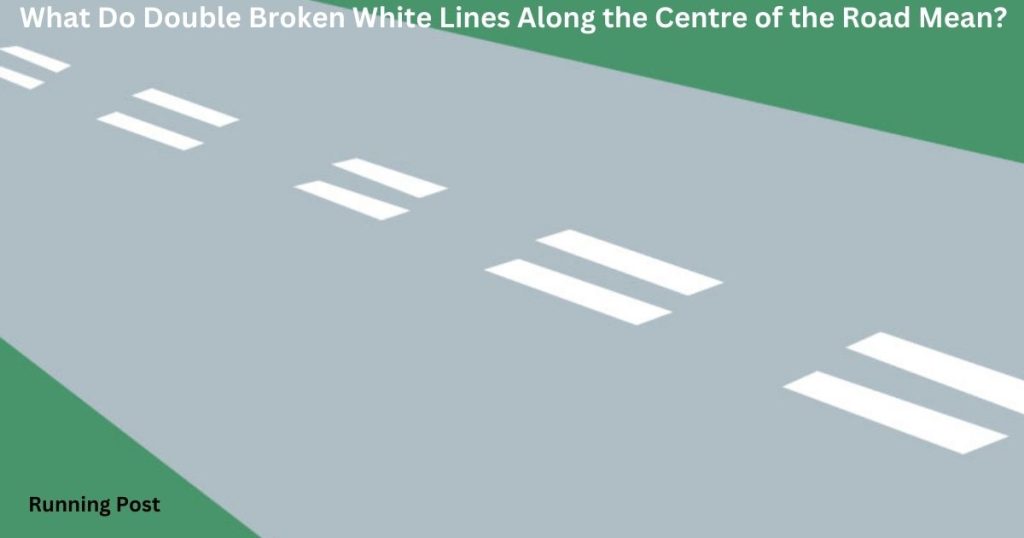| A: To change lanes to avoid a slow-moving vehicle | B: To pass parked vehicles on your side of the road | C: To pass a vehicle on the opposite side of the road | D: To overtake a vehicle traveling in the same direction |
Understanding Road Markings: Double Solid White Lines
What Are Double Solid White Lines?
Double solid white lines are a common road marking used to indicate that overtaking or lane changes are prohibited. These lines are typically painted in the center of the road, separating lanes of traffic moving in opposite directions. Their primary purpose is to ensure the safety of road users by clearly marking areas where crossing is not allowed.
Definition and Purpose
Double solid white lines are characterized by two parallel white lines, which are solid and do not have any gaps. These markings are used to denote a boundary that should not be crossed. The main purpose of these lines is to prevent drivers from overtaking other vehicles or changing lanes where it is deemed unsafe. This could be due to limited visibility, sharp curves, or other hazardous conditions. By restricting lane changes and overtaking in these areas, the lines help reduce the risk of accidents and maintain a smoother flow of traffic.
Typical Locations on the Road
You will often find double solid white lines on roads with high traffic volumes, especially on highways or main roads with frequent curves or intersections. They are also used in areas with poor visibility, such as near intersections, pedestrian crossings, or on narrow roads where overtaking could be particularly dangerous. Additionally, these lines are frequently seen in areas where vehicles may be parked, as crossing them to overtake parked vehicles is usually allowed under specific circumstances.
When May You Cross Double Solid White Lines?
While double solid white lines generally indicate that crossing is not allowed, there are specific scenarios where crossing them is permitted. Understanding these exceptions helps drivers navigate roadways safely and legally.
Permissible Scenarios for Crossing
The primary situation where crossing double solid white lines is allowed is to pass parked vehicles on your side of the road. This is often necessary when the parked vehicles are obstructing your lane and you need to maneuver around them to continue driving safely. However, it is crucial to exercise caution and ensure that there is no oncoming traffic or other hazards before crossing these lines.
Passing Parked Vehicles
When encountering parked vehicles, it is essential to assess the situation carefully. Before crossing double solid white lines, check for oncoming traffic and ensure that you have enough space to safely pass the parked vehicles. If it is safe to do so, move into the opposite lane temporarily to avoid the obstruction. This action should be performed smoothly and without excessive speed to avoid causing a hazard for other road users.
Emergency Situations
In emergency situations, crossing double solid white lines may also be permitted. For instance, if you are driving an emergency vehicle with flashing lights or if you need to move out of the way of an emergency vehicle, crossing these lines could be necessary. Always follow the instructions provided by emergency services and ensure that you do so safely and with consideration for other drivers.
You Also Like It:
Why are vehicles fitted with rear fog lights?
What’s the nearest you may park to a junction?
How should a load be carried on your roof rack?
What Does a Double Solid White Line Mean on the Road?
Double solid white lines have specific meanings and regulations associated with them. Understanding these rules is crucial for safe driving and compliance with traffic laws.
Regulations and Restrictions
The primary regulation associated with double solid white lines is that overtaking and lane changes are prohibited. This restriction is in place to prevent potentially dangerous maneuvers in areas where visibility or road conditions make overtaking risky. Drivers should remain in their lane and avoid crossing the lines unless the specific exceptions mentioned earlier apply.
No Overtaking
The no overtaking rule is enforced to ensure that drivers do not attempt to pass other vehicles in hazardous conditions. Double solid white lines are typically placed in areas where overtaking could lead to accidents, such as near curves, intersections, or where visibility is limited. By adhering to this rule, drivers contribute to overall road safety and prevent collisions.
Maintaining Lane Discipline
Maintaining lane discipline is crucial when driving in areas marked by double solid white lines. Drivers should stay within their designated lane and avoid crossing the lines unless absolutely necessary. This practice helps ensure a smooth flow of traffic and reduces the likelihood of accidents caused by improper lane changes.
What Do Double Broken White Lines Along the Centre of the Road Mean?

Double broken white lines serve a different purpose compared to solid lines. Understanding these markings helps drivers navigate roads where overtaking and lane changes are allowed under certain conditions.
Explanation of Double Broken Lines
Double broken white lines consist of two parallel lines with gaps between them. Unlike solid lines, these markings indicate that crossing the lines is permissible. They are used to denote areas where overtaking and lane changes are allowed, provided that it is safe to do so. These lines are typically found on roads with better visibility and less risk of collisions compared to areas marked by solid lines.
Allowed Lane Changes
When driving on roads marked with double broken white lines, drivers are allowed to change lanes and overtake other vehicles if necessary. However, it is essential to ensure that these maneuvers are carried out safely. Always check for other vehicles, signal your intentions, and ensure that there is enough space before crossing the lines. This helps prevent accidents and ensures smooth traffic flow.
Passing and Overtaking Rules
The rules for passing and overtaking on roads with double broken white lines are more flexible compared to those with solid lines. Drivers are permitted to overtake slower vehicles or change lanes to avoid obstructions. However, it remains crucial to exercise caution and follow road safety practices to minimize the risk of collisions and maintain safe driving conditions.
What Is the Meaning of Two White Lines on a Road?
Two white lines on the road can appear in different configurations, each with its own meaning and implications for driving.
Single vs. Double White Lines
Single white lines are used to indicate lane boundaries or to separate lanes of traffic moving in the same direction. Double white lines, however, are used to signify more critical restrictions, such as no overtaking zones. Understanding the distinction between single and double white lines helps drivers interpret road markings correctly and follow traffic regulations.
Solid vs. Broken Lines
Solid white lines indicate areas where lane changes or overtaking are not allowed, while broken white lines signify areas where these actions are permissible. Recognizing these differences is essential for adhering to road rules and ensuring safe driving practices.
Context and Interpretation
The context in which white lines are used on the road determines their meaning and how they should be interpreted. Always consider the road conditions, visibility, and any additional signage to accurately understand the implications of the white lines and drive safely.
Conclusion About When may you cross double solid white lines along the centre of the road?
Understanding road markings is essential for safe and compliant driving. Double solid white lines are a clear indicator of restricted areas where overtaking and lane changes are generally prohibited. They are placed in locations where crossing the lines could be dangerous, such as in areas with poor visibility or where road conditions make overtaking risky. However, there are specific scenarios, like passing parked vehicles on your side of the road or emergency situations, where crossing these lines is permitted.
On the other hand, double broken white lines signal that lane changes and overtaking are allowed, provided that it’s safe to do so. Recognizing the difference between solid and broken white lines helps drivers make informed decisions, maintain lane discipline, and navigate roadways safely.
By adhering to these road markings and understanding their meanings, drivers contribute to a smoother and safer driving experience for everyone on the road. Always remain vigilant and cautious, ensuring that your actions comply with road regulations and prioritize safety above all else.
You Also Like It:
When may you drive over a pavement?
What’s the national speed limit for a car on a single carriageway?
By how much can stopping distances increase in icy conditions?
Releated Posts
MAB Instructor Certification: Your Gateway to Professional Crisis Management Leadership
In today’s fast-evolving professional environments—especially in healthcare, mental health, education, and corrections—conflict and aggression can arise without warning.…
Freewayget.com: Your Ultimate Platform for Deals, Discounts, and Digital Products
Introduction to Freewayget.com In today’s fast-paced digital world, finding reliable platforms that offer authentic discounts, deals, and digital…
Affordable & Fast Embroidery Digitizing Services in Your Area
Embroidery digitizing services provide corporations, designers, and people with brilliant embroidery-equipped designs by means of changing art work…
Introduction to hdhub4u nit
In this article, we will delve into the details of hdhub4u nit, exploring its features, benefits, and why…
















